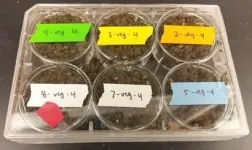(Press-News.org) The presence of high salt and nitrogen concentrations in high- tunnel soils may make it more challenging to rebuild a healthy soil microbiome following a soil-clearing event, according to microbial ecologists in Penn State's College of Agricultural Sciences.
Their research findings have important implications for soil fertility, and by extension, crop health and yield, explained Laura Kaminsky, a doctoral candidate in plant pathology, who led the investigation under the guidance of Terrence Bell, assistant professor of phytobiomes.
"Plants generally grow better with an active and diverse community of bacteria, fungi and other microbes in the soil," she said. "If these microbes are wiped out by a soil-clearing event, we want to know how quickly the soil microbiome bounces back and which microbes are most successful at re-establishing. Our study is laying the groundwork for the future development of guidelines that will aid farmers when rebuilding soil through microbial additives."
The researchers focused on agricultural systems that use high tunnels, which are plastic, greenhouse-like structures placed over a section of field soil. These structures are used to extend the growing season and to grow high-value crops such as tomatoes in a more protected setting.
However, the quality of the soil under high tunnels tends to degrade over time. "If the same crop is grown in a high tunnel year after year, pathogens specific to that crop accumulate at higher and higher levels in the soil and cause increasing amounts of crop disease," Kaminsky said.
One way to manage this increasing disease pressure is to reduce the population of pathogens by wiping out the entire soil microbial community, which is done with chemical fumigation or less harsh practices such as anaerobic soil disinfestation and soil solarization.
The problem, Kaminsky pointed out, is that these soil-clearing practices indiscriminately eliminate soil microbes, including microbes that provide benefits to crop plants and microbes that perform general soil functions like nutrient cycling.
Kaminsky and Bell's experiments, which took place in Buckhout Laboratory in 2018 and 2019, specifically looked at whether high soil salinity and high soil nitrogen concentrations -- two soil properties that often develop under high tunnels over time -- altered soil microbiome development.
To do that, the researchers buried small nylon mesh bags containing unsterilized "source" soil in sterilized "recipient" soil and left them to incubate for seven weeks. This allowed microbes to colonize out into the recipient soil, simulating how microbes from soil surrounding a cleared-soil area would colonize back into the cleared soil over time. Recipient soils were amended with salt, nitrogen, both or neither to determine whether these properties impacted the microbial communities' composition in the recipient soil.
The team sampled the recipient soil at two time points: one week and seven weeks of incubation. At each time point, researchers characterized the microbial community by measuring microbial biomass and taking a catalog of the bacterial species present using gene-sequencing techniques.
After the first week, the microbial communities had relatively low biomass and were dominated by a very limited set of species in the Bacillus and Paenibacillus genera. By seven weeks, there was a far larger and more diverse microbial community present.
"At each time point, there were certain bacterial species present in every single microcosm, regardless of the recipient soil treatment," Kaminsky said. "We called these 'universal colonizers,' and most of these were in the Bacillus or Paenibacillus genus. This is not surprising as these bacterial taxa are known to be ubiquitous and fast growing in soil environments."
In the recipient soils with salt and nitrogen added, the accumulation of biomass and bacterial diversity was significantly constrained relative to recipient soils with no additives. That is, higher soil salinity and higher soil nitrogen delayed the re-establishment of a diverse soil microbiome.
"It was not surprising that high soil salinity yielded this result, as salt poses a significant stress to many microbes," Kaminsky said. "It was somewhat surprising that high soil nitrogen yielded this result because nitrogen is a nutrient source instead of a stress. However, it may have favored a less diverse subset of fast-growing microbes, leading to the results we saw."
The findings, published in Environmental Microbiology, suggest that factors such as nutrient and salt accumulation, which can be particularly problematic in high tunnel systems, can be important in determining which colonizing microbes survive, Bell said. He noted that Kaminsky has developed Penn State Extension programs to share the results with growers.
"Laura has worked hard to develop both leading-edge research skills and communication skills that allow her to relay the state of knowledge in our field to farmers and other stakeholders," he said.
INFORMATION:
Paul Esker, assistant professor of epidemiology and field crop pathology, aided the project.
The U.S. Department of Agriculture Organic Transitions Program, the USDA-National Institute of Food and Agriculture, and the National Science Foundation Graduate Research Fellowship Program supported this work.
Scientists from Scientific and Educational Center «Smart Materials and Biomedical Applications» under the leadership of Kateryna Levada together with colleagues from Center for Immunology and Cellular Biotechnology of the Immanuel Kant Baltic Federal University conducted a joint interdisciplinary study on the development of a new method for treating leukemia using nanomaterials. The scientists analyzed how magnetic nanoparticles can be manipulated in in vitro conditions to achieve a selective antitumor effect. The method is based on the combined action of nanoparticles and permanent magnetic fields on human tumor cells.
Leukemia ...
Although clinical trial data are encouraging, real-world evidence with regard to the COVID-19 vaccine remains scarce. In particular, response to the vaccine among those previously infected with SARS-CoV-2 is still not completely understood.
Researchers from Bar-Ilan University and Ziv Medical Center now report preliminary evidence that people previously infected with the virus responded very strongly to one dose of the Pfizer vaccine, regardless of when they were infected and whether or not they had detectable antibodies against COVID-19 prior to receiving the vaccine.
Their study, published on February 11, 2021 in the journal Eurosurveillance, was conducted on a cohort of 514 staff members at Ziv Medical Center. Seventeen ...
DALLAS - Feb. 11, 2021 - Fusing the neck's top two vertebrae can prevent repeat strokes in children with bow hunter syndrome, a rare condition that affects a handful of U.S. pediatric patients each year, UT Southwestern researchers suggest in a recent study. The finding, published online in Child's Nervous System, offers a new way to treat these children and protect them from potentially lifelong neurological consequences.
Bow hunter syndrome - so named because of the head's position when a person is shooting an arrow - is a condition affecting children and adults in which turning the head compresses blood vessels supplying the back of the brain from the vertebral artery. In adults, this condition ...
A new study out of the University of Chicago has found that during the initial wave of the COVID-19 outbreak in New York City, only 1 in 5 to 1 in 7 cases of the virus was symptomatic. The research team found that non-symptomatic cases substantially contribute to community transmission, making up at least 50% of the driving force of SARS-CoV-2 infection. The results were published on Feb. 10 in the Proceedings of the National Academy of Sciences.
When the COVID-19 epidemic arrived in the U.S., the investigators noticed that it was very difficult to estimate what proportion of people infected with SARS-CoV-2 would go on to develop symptoms, partially due to the initial challenges with testing capacity.
"Without ...
As the number of pregnant women using opioid drugs continues to rise, questions have been raised about the long-term health effects on children exposed to these drugs in the womb. Researchers at the University of Maryland School of Medicine now have preliminary but striking evidence that suggests that such exposure can cause long-lasting impairment in the brain's ability to process sensory information. These impairments may give rise to autism, attention deficit hyperactivity disorder, and substance use disorders during adolescence. The landmark study, recently published in Journal ...
It was once thought that Ebola and related filoviruses were more or less contained to Central Africa. After a West African outbreak and the discovery of Reston ebolavirus in the Philippines, cuevavirus in Spain and various bat filoviruses in China, researchers now understand that this viral family--causing hemorrhagic fevers with up to 90% case fatality rates--has been widespread around the world for millions of years.
Our defenses against it are more embryonic, and though we have a vaccine against one species of Ebola and some therapeutic antibodies on the horizon, both have production or distribution issues. What doctors ...
At a glance:
New study suggests monetary reparations for Black descendants of people enslaved in the United States could have cut SARS-CoV-2 transmission and COVID-19 rates both among Black individuals and the population at large.
Researchers modeled the impact of structural racism on viral transmission and disease impact in the state of Louisiana.
The higher burden of SARS-CoV-2 infection among Black people also amplified the virus's spread in the wider population.
Reparations could have reduced SARS-CoV-2 transmission in the overall population by as much as 68 percent.
Compared with white people, Black individuals in the United States are more likely to be infected with SARS-CoV-2, more likely ...
In a recent article in the Journal of Osteopathic Medicine, authors gathered previously published research to summarize current thinking on the feasibility and efficacy of using scent detection dogs to screen for the COVID-19 virus. The researchers report that sensitivity, specificity, and overall success rates reported by the canine scent detection studies are comparable or better than the standard RT-PCR and antigen testing procedures.
These findings indicate scent detection dogs can likely be used to effectively screen and identify individuals infected with the COVID-19 virus in hospitals, senior care facilities, schools, universities, ...
EUGENE, Ore. -- Feb. 11, 2021 -- Researchers have mined and combined information from two databases to link pollen and key plant traits to generate confidence in the ability to reconstruct past ecosystem services.
The approach provides a new tool to that can be used to understand how plants performed different benefits useful for humans over the past 21,000 years, and how these services responded to human and climate disturbances, including droughts and fires, said Thomas Brussel, a postdoctoral researcher in the University of Oregon's Department of Geography.
The approach is detailed in a paper published online ...
Palo Alto, CA-- Understanding how plants respond to stressful environmental conditions is crucial to developing effective strategies for protecting important agricultural crops from a changing climate. New research led by Carnegie's Zhiyong Wang, Shouling, Xu, and Yang Bi reveals an important process by which plants switch between amplified and dampened stress responses. Their work is published by Nature Communications.
To survive in a changing environment, plants must choose between different response strategies, which are based on both external environmental factors and internal nutritional and energy demands. For example, a plant might either delay or accelerate its lifecycle, depending on the availability of the stored ...




